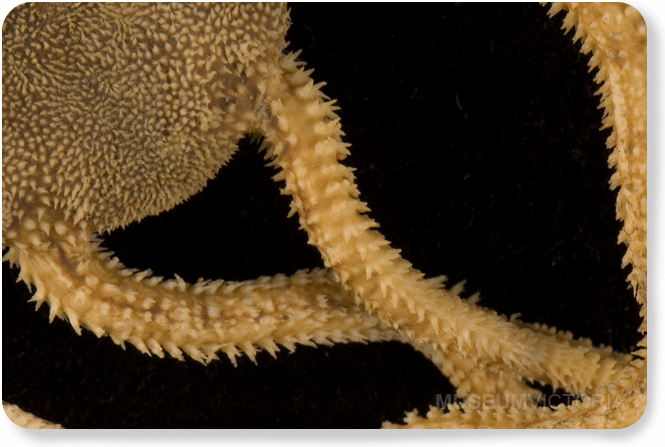
Home -> Species index -> Species description
 More images | Distribution map More images | Distribution map | F 54348. Family - Ophiomyxidae. |
Description The disc is flat, 25 mm diameter. The radial shields are covered. The dorsal surface is covered by skin bearing spines/granules; primary plates not visible. Disc spines or granules of one type, conical (skin covered), with 1 terminal point/thorn or 2 terminal points/thorns, and glassy transparent shaft. The spines are up to 0.3–1 mm long, and 2–5 times high as wide; densely distributed. The ventral interradial surface is with skin. The oral shields are covered in skin. The adoral shields are covered in skin. Bursal slits extend from the oral shield to the disc margin, not bordered by spines or papillae. The jaw is as wide as long or wider than long, with cluster of, pointed or tapering apical papilla, as wide as long, with thorns. Oral papillae separated by a gap from apical papillae, pointed, thorned. The oral tentacle pore is located inside the jaw or out of the jaw on top of the ventral disc, with no scales, with distal oral papilla none. The specimen has five arms, unbranched, moniliform, 11–14 times d.d. Dorsal arm plates not visible, covered by skin, without spines/granules. The second ventral arm plates are not visible, covered by skin. Ventral arm plates of the first free segments not visible, covered. Tentacle pores along the arm, with no scales. There are 1–3 arm spines on the first ventral segment, 5–6 on the first free segments. The spines are erect, extending around to the dorsal surface or extending laterally, subequal, and 0.5–1.5 times as long as one arm segment, pointed or blunt, cylindrical. There are thorns, in longitudinal series on the surface from the base to the tip of the spine, all along the spine, glassy transparent shaft.
Description exported from Delta key and to be finalised when DNA sampling completed. Note species description and image characters may vary slightly in animals of different size within the same species. Cite this publication as: "T O'Hara
(2010). ‘Ophiuroids from deep sea southern Australia. Museum Victoria. Version:
1.0 http://www.museumvictoria.com.au/stars" MUSEUMVICTORIA |